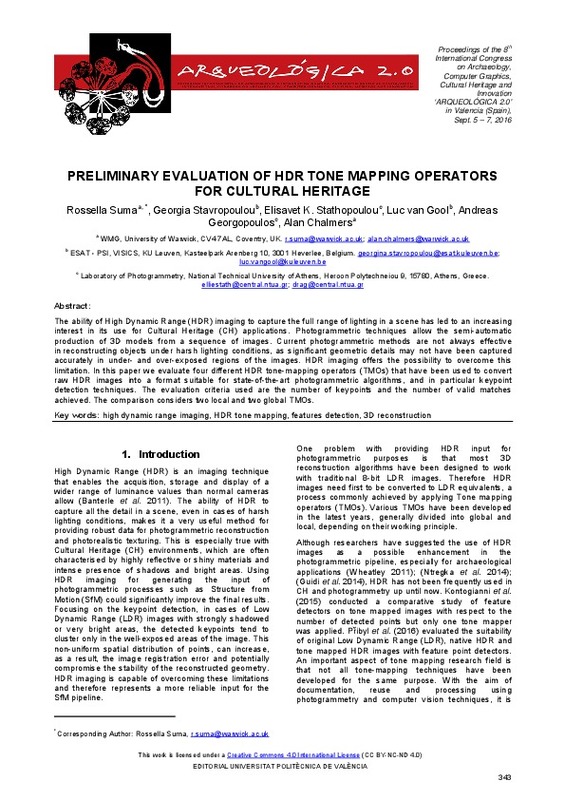JavaScript is disabled for your browser. Some features of this site may not work without it.
Buscar en RiuNet
Listar
Mi cuenta
Estadísticas
Ayuda RiuNet
Admin. UPV
PRELIMINARY EVALUATION OF HDR TONE MAPPING OPERATORS FOR CULTURAL HERITAGE
Mostrar el registro sencillo del ítem
Ficheros en el ítem
| dc.contributor.author | Suma, Rossella
|
es_ES |
| dc.contributor.author | Stavropoulou, Georgia
|
es_ES |
| dc.contributor.author | Stathopoulou, Elisavet
|
es_ES |
| dc.contributor.author | van Gool, Luc
|
es_ES |
| dc.contributor.author | Georgopoulos, Andreas
|
es_ES |
| dc.contributor.author | Chalmers, Alan
|
es_ES |
| dc.date.accessioned | 2017-07-26T07:35:21Z | |
| dc.date.available | 2017-07-26T07:35:21Z | |
| dc.date.issued | 2016-10-27 | |
| dc.identifier.isbn | 9788490484555 | |
| dc.identifier.uri | http://hdl.handle.net/10251/85757 | |
| dc.description.abstract | [EN] The ability of High Dynamic Range (HDR) imaging to capture the full range of lighting in a scene has led to an increasing interest in its use for Cultural Heritage (CH) applications. Photogrammetric techniques allow the semi-automatic production of 3D models from a sequence of images. Current photogrammetric methods are not always effective in reconstructing objects under harsh lighting conditions, as significant geometric details may not have been captured accurately in under- and over-exposed regions of the images. HDR imaging offers the possibility to overcome this limitation. In this paper we evaluate four different HDR tone-mapping operators (TMOs) that have been used to convert raw HDR images into a format suitable for state-of-the-art photogrammetric algorithms, and in particular keypoint detection techniques. The evaluation criteria used are the number of keypoints and the number of valid matches achieved. The comparison considers two local and two global TMOs. | es_ES |
| dc.format.extent | 4 | es_ES |
| dc.language | Inglés | es_ES |
| dc.publisher | Editorial Universitat Politècnica de València | es_ES |
| dc.relation.ispartof | 8th International congress on archaeology, computer graphics, cultural heritage and innovation | es_ES |
| dc.rights | Reconocimiento - No comercial - Sin obra derivada (by-nc-nd) | es_ES |
| dc.subject | Data acquisition | es_ES |
| dc.subject | Photogrammetry | es_ES |
| dc.subject | Remote sensing | es_ES |
| dc.subject | Documentation | es_ES |
| dc.subject | Cultural heritage | es_ES |
| dc.subject | Digitisation | es_ES |
| dc.subject | 3D modelling | es_ES |
| dc.subject | Virtual archaeology | es_ES |
| dc.subject | Virtual museums | es_ES |
| dc.subject | Virtual exhibitions | es_ES |
| dc.subject | Gaming | es_ES |
| dc.subject | Collaborative environments | es_ES |
| dc.subject | Internet technology | es_ES |
| dc.subject | Social media | es_ES |
| dc.subject | Architecture | es_ES |
| dc.title | PRELIMINARY EVALUATION OF HDR TONE MAPPING OPERATORS FOR CULTURAL HERITAGE | es_ES |
| dc.type | Capítulo de libro | es_ES |
| dc.type | Comunicación en congreso | es_ES |
| dc.identifier.doi | 10.4995/arqueologica8.2015.3582 | |
| dc.rights.accessRights | Abierto | es_ES |
| dc.description.bibliographicCitation | Suma, R.; Stavropoulou, G.; Stathopoulou, E.; Van Gool, L.; Georgopoulos, A.; Chalmers, A. (2016). PRELIMINARY EVALUATION OF HDR TONE MAPPING OPERATORS FOR CULTURAL HERITAGE. En 8th International congress on archaeology, computer graphics, cultural heritage and innovation. Editorial Universitat Politècnica de València. 343-347. https://doi.org/10.4995/arqueologica8.2015.3582 | es_ES |
| dc.description.accrualMethod | OCS | es_ES |
| dc.relation.conferencename | ARQUEOLÓGICA 2.0 - 8th International Congress on Archaeology, Computer Graphics, Cultural Heritage and Innovation | es_ES |
| dc.relation.conferencedate | September 05-07,2016 | es_ES |
| dc.relation.conferenceplace | Valencia, Spain | es_ES |
| dc.relation.publisherversion | http://ocs.editorial.upv.es/index.php/arqueologica20/arqueologica8/paper/view/3582 | es_ES |
| dc.description.upvformatpinicio | 343 | es_ES |
| dc.description.upvformatpfin | 347 | es_ES |
| dc.type.version | info:eu-repo/semantics/publishedVersion | es_ES |
| dc.relation.pasarela | OCS\3582 | es_ES |








